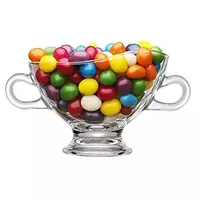Dragee sweets

Dragee sweets got their original name thanks to the French word dragée, which does not mean a sweet treat at all, but a dosage of the drug in solid form. Moreover, dragee medicine is produced by layer-by-layer application of an active drug substance on microparticles-bases, so-called inert carriers, using sugar glaze or syrup.
Later, confectioners began to call dragee sweets similar in shape to medicinal pills. Nowadays, the word dragee is staunchly associated with multi-colored small sweets of round shape. Dragee sweets are covered with a glossy shell of various bright colors. Often dragee sweets have a sugar surface. Remarkably, the first medicinal dragee sweets were known to ancient people.
In Babylon, as well as in Persia, the first dragee sweets were made, which were popular with people, as evidenced by archaeological finds of that period. It is noteworthy that the grains of cereal crops served as the basis for the ancient dragees. For example, dragee from candied grains of cumin, anise or coriander. Since ancient times, incredibly useful and natural cranberry dragee sweets have been made in Russia.
Until now, you can easily buy dragee "Cranberries in Sugar" in the confectionery department of any grocery store. Under the protection of the sugar shell is a storehouse of vitamin substances, which in excess contain cranberry berry. The bright and richly acidic fruit of the red berry is perfectly combined with the sugar shell of the dragee. Children simply adore bright sweets, and the Cranberry in Sugar dragee can not only be a tasty and sweet treat, these sweets will bring tangible and visible benefits to your child's health.
Dragee composition
Often, in the composition of dragees, you can find a large amount of sugar and, as a result, a high indicator of the level of calories and carbohydrates in the product. The average caloric level of dragee is 516 Kcal per 100 grams of sweet product, which is close enough to the indicators of chocolates. In addition to sugar, a number of useful macro- and trace elements such as calcium, magnesium, sodium, potassium, iron, phosphorus and vitamins of the PP group can be found in the dragee.
Dragee candy consists of a filling or body that is surrounded by layer after layer of sugar or sugar glaze. Usually, a variety of food dyes are used to stain dragees, which are not always considered harmless to the human body. Therefore, it is worth carefully studying the composition of dragees, because not only excessive sugar content and high calorie content can be harmful, but also poisonous coloring substances.
Types of dragees
There is a wide variety of dragee species, which differ from each other in only two criteria. Depending on the type of body, dragees are: liqueur, jelly, fruit, fondant, sugar, caramel, nut, marzipan, grain proline, shaved, blanched or sprayed berries and fruits, as well as dragees from dried berries and fruit fruits.
Also, the type of dragee depends on the shell of the candy. So there are dragees in a sugar, chocolate, crisp and uneven shell on the surface. It is believed that dragees can be useful when they are based on: berries (like cranberries), raisins, nuts or other natural ingredients, in which a large amount of nutrients and vitamins can be found.
candy dragee 516.3 kCal
Energy value of dragee sweets (Ratio of proteins, fats, carbohydrates - ju):
Proteins: 10 g (~ 40 kCal)
Fats: 35g (~ 315 kCal)
Carbohydrates: 43g (~ 172 kCal)
Energy ratio (bj | y): 8% | 61% | 33%
 Español
Español Français
Français Português
Português Русский
Русский 简体中文
简体中文 繁體中文
繁體中文 日本語
日本語 한국어
한국어 العربية
العربية Türkçe
Türkçe Қазақ
Қазақ Deutsch
Deutsch Italiano
Italiano Українська
Українська
